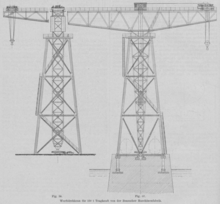Beardmore Crane
The Beardmore Crane was a giant cantilever crane at the William Beardmore and Company yard.
Design

The Beardmore Crane had two opposite cantilevered jibs, both equipped with moving winches, for a total length of 233 feet (71 m).[1] From the job to the ground extended a tapering lattice, which was enclosed by a lattice tower. The jib was slewed by a mechanism on the ground, and bearings at the top of the tower and where the extension met the ground allowed it to turn.[1][2] The winch on each arm was powered by two 52 horsepower (39 kW) electric motors for hoisting and two 14 horsepower (10 kW) motors for slewing, and a 18 horsepower (13 kW) motor for slewing.[1] The tower took eight minutes to make a full revolution.[1]
The height of the rail on which the winches ran was 154 feet (47 m), and communication with the operator was by speaking tube.[1] The total weight of the structure was over 500 tonnes (490 long tons; 550 short tons).[1] Upon completion, the shorter arm was tested to lift 200 tonnes (200 long tons; 220 short tons) at a radius of 72 feet 2 inches (22.00 m) and the longer arm could lift 50 tonnes (49 long tons; 55 short tons) at a radius of 139 feet 5 inches (42.49 m).[1]
Railway tracks running beneath the crane allowed material to be moved from the workshops.[3]
It was used for fitting out ships, installing very heavy items such as boilers, armour and guns.[1] The basin it served was the largest in the world at the time of its completion.[4]
History

The crane was built by Benrather Maschinenfabrik near Düsseldorf, now Demag, and is similar to a crane built for Vickers in Barrow-in-Furness.[5] The two cranes were the first modern high capacity cranes in Britain.[5] Other shipbuilders installed massive cranes soon after, such as the Titan Clydebank in 1907, although these were typically British-built and of a different design.[6]
The crane was erected in 1903 at a cost of GB£3,352 by German firm Kohncke.[5] The yard was short-lived, lasting from 1899-1930, but saw significant action during the First World War when it built a number of ships for the Royal Navy.[7]
The Beardmore Crane was demolished c. 1971.[8][9]
References
- Johnston 1993, p. 19
- "Die Hebezeuge auf der Düsseldorfer Ausstellung". Polytechnisches Journal (in German). 317: 479–483. 1902.
- "Entwicklung und gegenwärtiger Stand der modernen Hebezeugtechnik". Polytechnisches Journal (in German). 323: 115–118. 1908.
- Todd, Daniel; Lindberg, Michael (1996). Navies and Shipbuilding Industries: The Strained Symbiosis. Greenwood Publishing Group. p. 111. ISBN 978-0-275-95310-2.
- Johnston 1993, p. 18
- Johnston 1993, pp. 18—19
- Stratton, Michael; Trinder, Barrie (2014). Twentieth Century Industrial Archaeology. Taylor & Francis. p. 77. ISBN 978-1-136-74801-1.
- "Clydebank High School Reunion Charter". Paddle Steamer Preservation Society. Retrieved 23 January 2015.
- "Doon the Watter 1955-56". Paddle Steamer Preservation Society. Retrieved 23 January 2015.
Sources
- Johnston, Ian (1993). Beardmore Built: The Rise and Fall of a Clydeside Shipyard. Clydebank District Libraries & Museums Department. ISBN 9780906938089.CS1 maint: ref=harv (link)